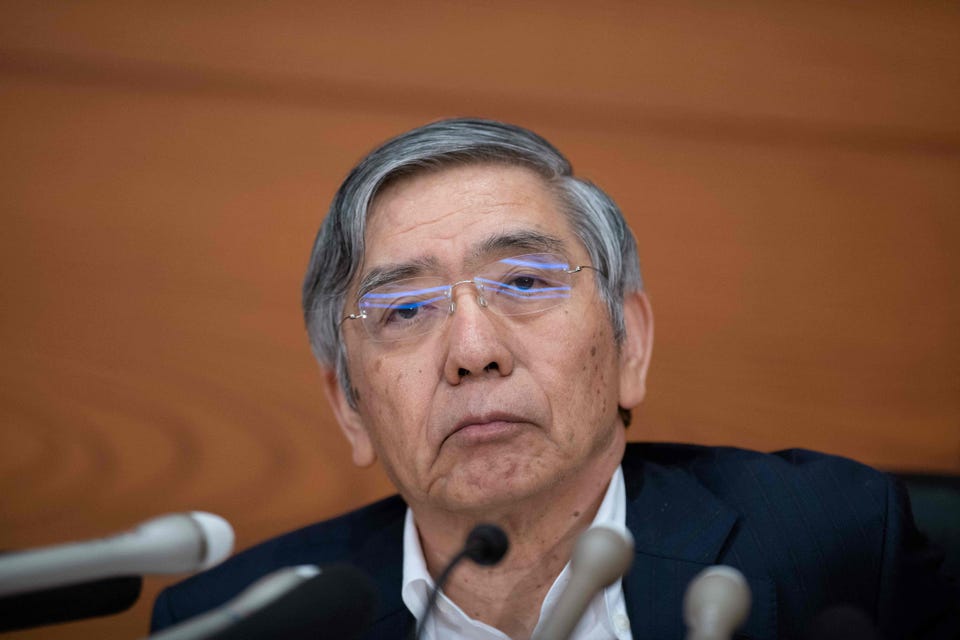The deer-in-the-headlights moment that Bank of Japan Governor Haruhiko Kuroda is suffering through isn’t just painful to watch. It’s a clear and present danger to the outlook for Asia’s No. 2 economy.
The yen’s journey toward 150 to the dollar is thought to be a threat to Japan’s 2022. The focus tends to be on how inflation is surging at a 3% rate, by some measures. That’s well above the BOJ’s 2% target and a world away from the deflation that was the zeitgeist just 12 months ago.
The U-turn has global markets wondering what, oh what, Kuroda is doing standing pat while central bankers virtually everywhere boost interest rates. The widening divergence between Japanese and U. S.
yields has the yen cascading past 30-year lows. Is 160 next? Or even 170, as former Japanese Vice Minister of Finance Eisuke Sakakibara, known widely as “Mr. Yen,” warns? To see Kuroda’s calm seems to suggest that Sakakibara and other yen bears are overthinking risks.
Yet the real problem is one all too many economists ignore: how much worse off Japan might be 10 years from if now if the BOJ doesn’t stop feeding the economy unlimited steroids. Were time travel possible, it would be fascinating to return to the 2006-2007 era of BOJ policymaking—and stay the course. That was two BOJ governors ago, back when Toshihiko Fukui was calling the shots at central bank headquarters in Tokyo.
By the time he took the reins in 2003, Tokyo was three years into the globe’s first experiment with quantitative easing. Fukui decided it was time to release Japan from the intensive-care unit. QE, after all, was meant to bring the economy back from a kind of near-death experience.
It was never meant to be permanent. Fukui began lowering the monetary dosage . Then in July 2006, he pulled off an official rate hike.
Then a second one in early 2007. Not surprisingly, the empire struck back. Investors, banks, companies and politicians howled in protest.
Before long, Fukui was on the defensive. The rate hikes stopped. By 2008, the first act by Fukui’s successor Masaaki Shirakawa was to slash rates back to zero and restore some elements of QE.
In 2013, Kuroda was hired to turbocharge things. He hoarded bonds, stocks and other assets. By 2018, the BOJ’s balance sheet topped the size of Japan’s entire $5 trillion economy, a first for a Group of Seven nation.
Imagine, though, if Fukui’s efforts to normalize Japan Inc. ’s relationship with central bank-underwritten corporate welfare had lasted. U.
S. economists lamenting the reversal of former Federal Reserve Chair Janet Yellen’s own “Fukui moment” will understand this exercise. Beginning in late 2015, Yellen ended Lehman Brothers-crisis-era QE and began hiking rates.
When Jerome Powell grabbed the baton in 2018, he stayed the course on Yellen’s rate normalization regimen. Until then-President Donald Trump threatened to fire him. So, the Fed began cutting rates back toward zero well before Covid-19 hit—well before the biggest economy needed fresh steroids.
What if Powell had done his job, ignored Trump and resisted rate cuts? This what-if is even more maddening for today’s BOJ watchers. If Japan had kicked its addiction to BOJ cash 15 or 16 years ago, Canon, Sony, Toyota and other Japan Inc. giants would’ve had incentives to raise their innovative and competitive games.
The succession of governments that have led since the mid-2000 would’ve been pressured to do their jobs and implement bold structural reforms. Instead, elected officials and chieftains have been able to do the bare minimum. All just got used to returning to the BOJ’s ATM window, time and time again.
All this largess enabled Japan to punt big decisions well into the future. In 2022, the punting continues. This brings us to Kuroda’s current conundrum.
Because Japanese officialdom and private sector CEOs continue to live off one monetary hit after another—knowing there’s always more where that came from—there are zero reasons to take risks, do heavy lifting or try something different. So, a policy aimed at supporting zombie companies zombified an entire G7 economy . Now, Kuroda is telling Japan Inc.
, and the world, that zero is changing strategy-wise. And that the yen morphing into the peso right before our eyes is just fine. True, a hike right now would be too destabilizing to contemplate.
But the idea that Kuroda has nothing in the way of new strategies is deeply troubling. Even a cosmetic rebalancing of asset purchases—or the mere hint of one to come—might remind the globe that Tokyo policymakers still have a pulse. And that the yen heading to 160, or beyond, is not okay.
.
From: forbes
URL: https://www.forbes.com/sites/williampesek/2022/10/31/japanese-yen-risks-being-rebranded-as-the-peso/



